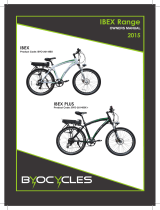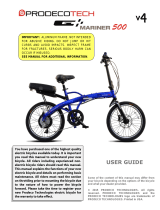Page is loading ...

OWNERS MANUAL
Charging Batteries – Up-right type - Li-ion
To charge the battery, follow these steps:
Step 1 – Unlock the battery by using the key & take the battery out of the bike.
Step 2 – Connect the charger’s DC connector to the battery socket.
Step 3 – Plug the charger to a domestic AC outlet (100-240VAC).
Step 4 – Unplug the charger from the AC outlet after charging is completed.
Step 5 – Unplug the charger’s DC connector from the battery socket.
Charging a battery takes around 3.0 hours depending upon the state of charge.
Li-ion battery Charger (Model Name: EBBC11-LI36SRT03) can only charge following
battery pack:
Battery MODEL: EBBA-ST36-U (9000mh typical)

NOTIFICATION:
1. When indicator is abnormal or charger fails to work normally, please check the
following:
(1) Selecting switch set on the proper position?
(2) Both polarities (+/-) connected correctly?
(3) Any fuse burned out?
If abnormal status remains, do not open the charger. Contact our local distributor or
SR SUNTOUR customer service department for prompt service.
2. If you won't use the charger for a long time, unplug the AC cord for security and
prolong the charger life.
3. We suggest replacing the battery when it fails to hold a full charge. It might be due to
the battery being past its useful life.

LED Battery Status Indicator
The LED status indicator on the battery pack can indicate the condition of Remaining
capacity, Absolute capacity and Charge count.
Remaining capacity
Remaining capacity is the “fuel gauge” of
the battery.
Absolute capacity
Absolute capacity is the comparison of
typical full charging capacity and Actual
full charging capacity. With this, a user
can know the overall condition of the
battery.
Charge count
Charge count is the number of times the
battery has been charged.
● Operation
LED indication changes by pushing the button as follows:
Item
Operation
Remaining capacity
One push of the Button.
Absolute capacity
Push Button and hold for 3 secconds
Charge count
Push Button and hold for 6 seconds

The format of the indication
The information is expressed as the following formats.
● Remaining Capacity
LED Indicator
Remaining capacity
●●●●
100
-
75
%
●●●○
75
-
50
%
●●○○
50
-
25
%
●○○○
25
-
10
%
◎○○○
10
-
0
%
◎◎◎◎
Over Temperature
LED light indicators:
○No Lighting
●Lighting
◎Blink (1/8Sec)
● Absolute Capacity
LED Indicator
Absolute Capacity
●●●◎
-
80
%
●●◎○
79
-
70
%
●◎○○
69
-
60
%
◎○○○
59
-
%
○No Lighting
●Lighting
◎Blink (1/4Sec)
● Charge Count
LED Indicator
Charge Count
●●●●
0
-
99
●●●○
100
-
189
●●○○
190
-
269
●○○○
270
-
349
◎○○○
350
-
0
○No Lighting
●Lighting
◎Blink(1/4Sec)

Battery Range
(1) Factors affecting Range
The following table shows the A-Z - the many factors that affect battery range.
A
Ambient Temperature of Battery when charging (lower = better)
B
Ambient Temperature of Battery when not in use (higher = better)
C
Ambient Temperature of Bike in use (higher = better)
D
Battery Age (newer = better)
E
Battery charge cycles (number of time charged)
F
Battery Condition (state of charge)
G
Battery Recovery Time (how soon after last journey)
H
Battery Storage (cool, dry place recommended)
I
Brake usage
J
Driver ability
K
Driver concentration (inadvertently braking with the throttle open)
L
Driving techniques
M
Condition/repair state (a well-serviced bike improves range)
N
Obstacles on journey
O
Speed – Average
P
Speed – Variability
Q
Terrain – Slope
R
Terrain – Surface
S
Terrain – Variability
T
Traffic conditions (including vehicles, pedestrians and cyclists)
U
Tire condition (regularly check for damage)
V
Tire Pressure (always keep within recommended range)
W
Weight of driver
X
Wind direction
Y
Wind speed

(2) Maximising the Range
Charge the battery at room temperature 5ºC to 35º C. (41ºF to 95ºF)
Discharge the battery as much as possible before recharging.
Use your gears. Downshift when accelerating or riding uphill.
Don’t ride with under-inflated tires and keep the chain clean and well lubricated.
(3) Battery Life
If used and maintained properly it should last at least 600 charging cycles.
Do not recharge the battery continuously for more than 24 hours. This can seriously
reduce the life of the battery.
If the range per charge becomes too short, the battery’s life may have come to an end.
Replace the battery with a new one from your Authorised SR SUNTOUR Dealer.
(4) Extended Storage
Fully charge the battery.
Recommended storage temperature: -20ºC to 35ºC ( -4ºF to 95º F)
Charge the battery every 3 months.

Safety Precautions
Recharge the battery before each journey, and always recharge it if unused for one
month.
Charge the Li-ion battery indoors at a temperature between 5ºC to 35º C. (41ºF to 95ºF)
Li-ion battery charger cannot charge battery with temperature 60ºC more or -3ºC less.
Do not recharge your battery in direct sunlight or in a very hot environment.
Avoid any contact with water when recharging your battery. If the plug or socket does
get wet, dry it thoroughly before proceeding.
Be sure to keep pets and small children away from the area where you are recharging.
If you notice a strange smell or smoke, disconnect the power immediately and take both
your battery and charger to your authorized dealer for service or replacement.
Do not recharge the battery continuously for more than 24 hours. This could seriously
reduce the life of the battery.
Keep the area where the battery is charged well ventilated. Keep it free from litter and
anything combustible to avoid fire from sparks or overheating.
Use only genuine SRSUNTOUR Batteries and Chargers with your bike, anything else
invalidates your warranty and may cause irreparable harm.
Do not throw the battery into a fire.
Do not use the battery with other appliances or charge other batteries with the charger.
Do not disassemble or modify the battery or charger.
Do not connect positive and negative terminals by using metallic objects; be especially
careful when inserting any key to ensure that it is not accidentally inserted into the
charger socket on the battery.
Do not submerge the battery or charger. Soaking either in water may cause irreparable
damage.
Do not subject the battery or charger to shocks, e.g. by dropping.
Do not touch the charger with your skin for long periods during charging. Burning of
the skin may result.
Do not cover the charger or place objects on it.
Place the charger firmly on a flat surface. Using the charger upside-down or stretching
the cord tight may result in malfunction, fire or electric shock.
Be sure to insert the Power Source Plug fully into a wall socket.
Do not touch the Power Source Plug with wet hands.
Keep the Power Source Plug clean and free of dust, clean regularly.
To remove the Power Source Plug from a socket, do not pull the cable, pull the plug.
Do not rotate the pedals when charging the battery whilst it is mounted on the bicycle.
The cord may twist around the pedal or the crank, and damage the cable and or plug. In
extreme conditions it may cause an electric shock or fire.
Use only a power source rated at 100-240 volts AC.
Do not use damaged components – consult your authorised SR SUNTOUR Dealer
immediately.
If the supply Cord is damaged, it must be replaced by the Manufacturer or its service
agent or a similarly qualified person in order to avoid a hazard.

Precautions for use of the battery
1. Precautions for use of the battery in a cold climate
Charge and discharge are the effects of a chemical reaction inside the battery. The
capacity of a battery declines in cold weather because the chemical reaction isn't as
active when the temperature is low. The mileage of E-bikes then often becomes shorter
in this case but note the cause of this phenomenon is not battery failure. We advise
when riding in colder conditions that you store the battery inside (more than 10°C)
when you are not riding. We also recommend that you charge the battery indoors where
the temperature is higher.
2. Precautions for long term battery storage
Remaining capacity decreases even if you don't use the battery, because the chemical
reaction continues and then a protection circuit becomes active. Our advice regarding
long-term storage is as follows.
1) When a battery is kept in the fully charged condition for a long time, the battery
suffers some damage. Try to keep the battery in a capacity condition that 3
LEDs of the remaining battery capacity indicator are turned on.
2) When the battery is completely discharged for a long time, the battery suffers
damage. Check the remaining capacity with the LED indicator every 3 months.
If, when checking the remaining-capacity status, only one or two of the LED’s
are lit, charge the battery until 3 LEDs are lit.
3) DO NOT leave a battery in high temperature environment. When temperature is
high, chemical reaction becomes more active, and the remaining capacity
decrease rapidly. Keep the battery in a dry place where it isn't exposed to direct
sunlight and the ambient temperature is less than 30°C).
4) Store the battery in a plastic bag to prevent a short circuit.
Upright
type
Push the above button to check remaining battery capacity. For long-term storage, 3
lights is ideal. Check capacity every 3 months and re-charge as necessary.
/








